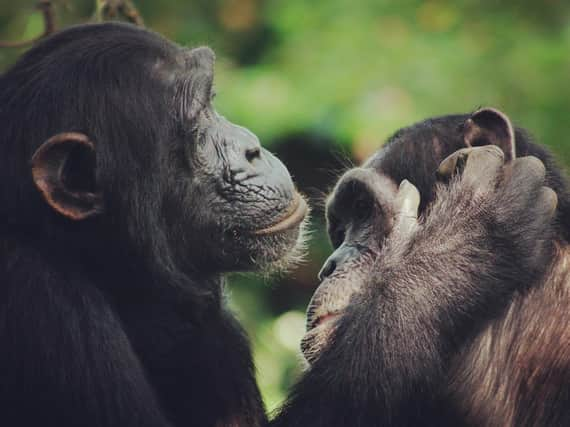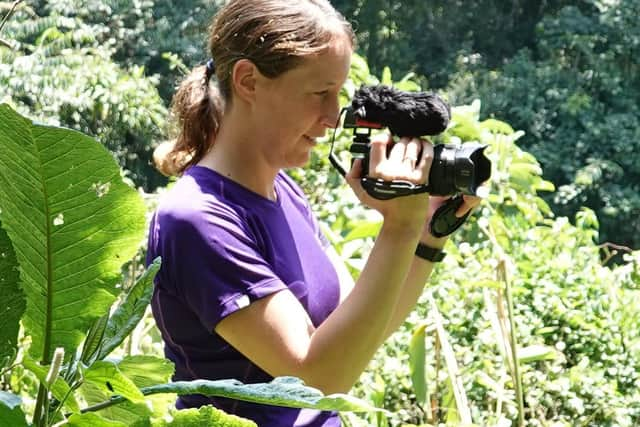Yorkshire scientists help trace evolution of human speech back to primates


Chimpanzee lip-smacks exhibit a speech-like rhythm, confirming that human speech has ancient roots within primate communication, according to a new study.
The project was a collaboration between the University of York, the University of St Andrews and the University of Warwick.
Advertisement
Hide AdAdvertisement
Hide AdResearchers found that, like every human language in the world, chimpanzees produce lip-smacks at a speech-like rhythm of close to five open-close mouth cycles per second.


The findings suggest the vocal systems in human speech have their origins in these primate mouth signals, offering answers to the long-standing puzzle of how human speech evolved.
Professor Katie Slocombe, co-author of the study, from the department of psychology at the University of York, said: "Our study suggests that human speech has deep evolutionary roots and likely ‘piggy-backed’ on rhythmic facial movements that existed in our shared ancestors with other primates."
Previously research had already identified fast-paced mouth signals with a speech-like rhythm in orangutans and several other monkey species, but until now there has been no evidence from African apes, who are more closely related to humans.
Advertisement
Hide AdAdvertisement
Hide AdThe team looked at data from four chimpanzee populations - two wild and two held in captivity.
Their speech was analysed through video recordings collected at Edinburgh Zoo and Leipzig Zoo, and recordings of wild communities including the Kanyawara and the Waibira, both in Uganda.
Lead author of the study Dr Adriano Lameira, from the University of Warwick said the results prove that spoken language was pulled together within our ancestral lineage using "ingredients that were already available" and in use by other primates and hominids.
Dr Lameria said the team found pronounced differences in rhythm between chimpanzee populations, suggesting that these are not the automatic and stereotypical signals so often attributed to our ape cousins.
Advertisement
Hide AdAdvertisement
Hide AdHe said: "Instead, just like in humans, we should start seriously considering that individual differences, social conventions and environmental factors may play a role in how chimpanzees engage “in conversation” with one another.
"If we continue searching, new clues will certainly unveil themselves. Now it’s a matter of mastering the political and societal power to preserve these precious populations in the wild and continue enabling scientists to look further."
________________________________
Editor’s note: first and foremost - and rarely have I written down these words with more sincerity - I hope this finds you well.
Almost certainly you are here because you value the quality and the integrity of the journalism produced by The Yorkshire Post’s journalists - almost all of which live alongside you in Yorkshire, spending the wages they earn with Yorkshire businesses - who last year took this title to the industry watchdog’s Most Trusted Newspaper in Britain accolade.
Advertisement
Hide AdAdvertisement
Hide AdAnd that is why I must make an urgent request of you: as advertising revenue declines, your support becomes evermore crucial to the maintenance of the journalistic standards expected of The Yorkshire Post. If you can, safely, please buy a paper or take up a subscription. We want to continue to make you proud of Yorkshire’s National Newspaper but we are going to need your help.
Postal subscription copies can be ordered by calling 0330 4030066 or by emailing [email protected]. Vouchers, to be exchanged at retail sales outlets - our newsagents need you, too - can be subscribed to by contacting subscriptions on 0330 1235950 or by visiting www.localsubsplus.co.uk where you should select The Yorkshire Post from the list of titles available.
If you want to help right now, download our tablet app from the App / Play Stores. Every contribution you make helps to provide this county with the best regional journalism in the country.
Sincerely. Thank you.
James Mitchinson
Comment Guidelines
National World encourages reader discussion on our stories. User feedback, insights and back-and-forth exchanges add a rich layer of context to reporting. Please review our Community Guidelines before commenting.